British Troops coming ashore on Gold Beach 6th June 1944
6th June 2019 Activity Plan
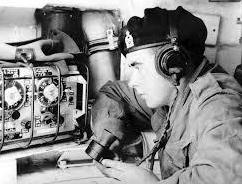 From
From the early morning of 6th June 2019,
Martin Smyth, M0MGA and
Tony Barron, G3YYH, are planning tp operate a portable station on the British
Gold King Red Beach where in 1944 the 5th East Yorkshires and 6th Green Howards came ashore under enemy fire. At the same time,
David Coles, M0IDF,will be operating from the site of the glider landings made by the Oxfordshire & Buckinghamshire Light Infantry to sieze the bridge over the river Orne at Ranville and the Bénouville bridge
, now named
Pegasus Bridge in honour of the Parachute Regiment, a short distance
up the Caen Canal from the ferry port at
Ouistreham. The HF equipment planned for use in this exercise is the same as that used extensively by British and Canadian forces on that historic day in 1944 and at Gold Beach will consist of a
Wireless Set No.19 MkIII HP operating with its high power unit
and
using 12 volt batteries for the power supply. The aerial will be an inverted V cut for the operating frequency of
3.615 Mc/s on the 80m amateur band, The station will also have a pair of crystal controlled
Wireless Set No.46 manpacks which were widely used for communications on the beaches. At Pegasus Bridge David is planning to use either a
Wireless Set No.19 MkIII or a New Zealand built
ZC1 transceiver along with a
PCR1 general coverage receiver. He will also be fielding a
Clansman 320 HF manpack and will be operating from a 1942 Bedford MWD lorry. The aerials available at this location are planned to be 3/4 wave length long wires for 80 mtrs. and 40 mtrs. and whips for the lorry. All communications on
3.615 Mc/s will be made in Amplitude Modulation.


In addition to working on AM and FM
David, M0IDF is intending to operate SSB equipment from the Pegasus Bridge site and with a planned schedule on either 40m or 80m to make direct LSB contact with the Light Criuser
HMS Belfast, now a floating museum located in the Pool of London. HMS Belfast was the
Flag Ship of Rear Admiral Frederick Dairymple-Hamilton and the lead ship of Bombardment Force E, tasked with supporting the British and Canadian Gold and Juno Beach Sectors.
Southdown Amateur Radio Society (SARS) will be active under the call sign
GB2SF(Sword Force) from 6th - 8th June, operating from
Beachy Head at the former NATO radio navigation site. They are commemorating the British troops who sailed from that area of the South Coast to attack the designated Sword Beach on 6th June. Equipment being operated on 3.615 Mc/s using AM will be a
Wireless Set No.19 MkIII and a
Wireless Set No.62 station. On
51.700 Mc/s they will be using a
Clansman VRC353 set. SARS will also be working HF bands in SSB modes from Beachy Head using a
Clansman VRC322.Updates of SARS news about this station will be posted on their website which can be found on
this link. 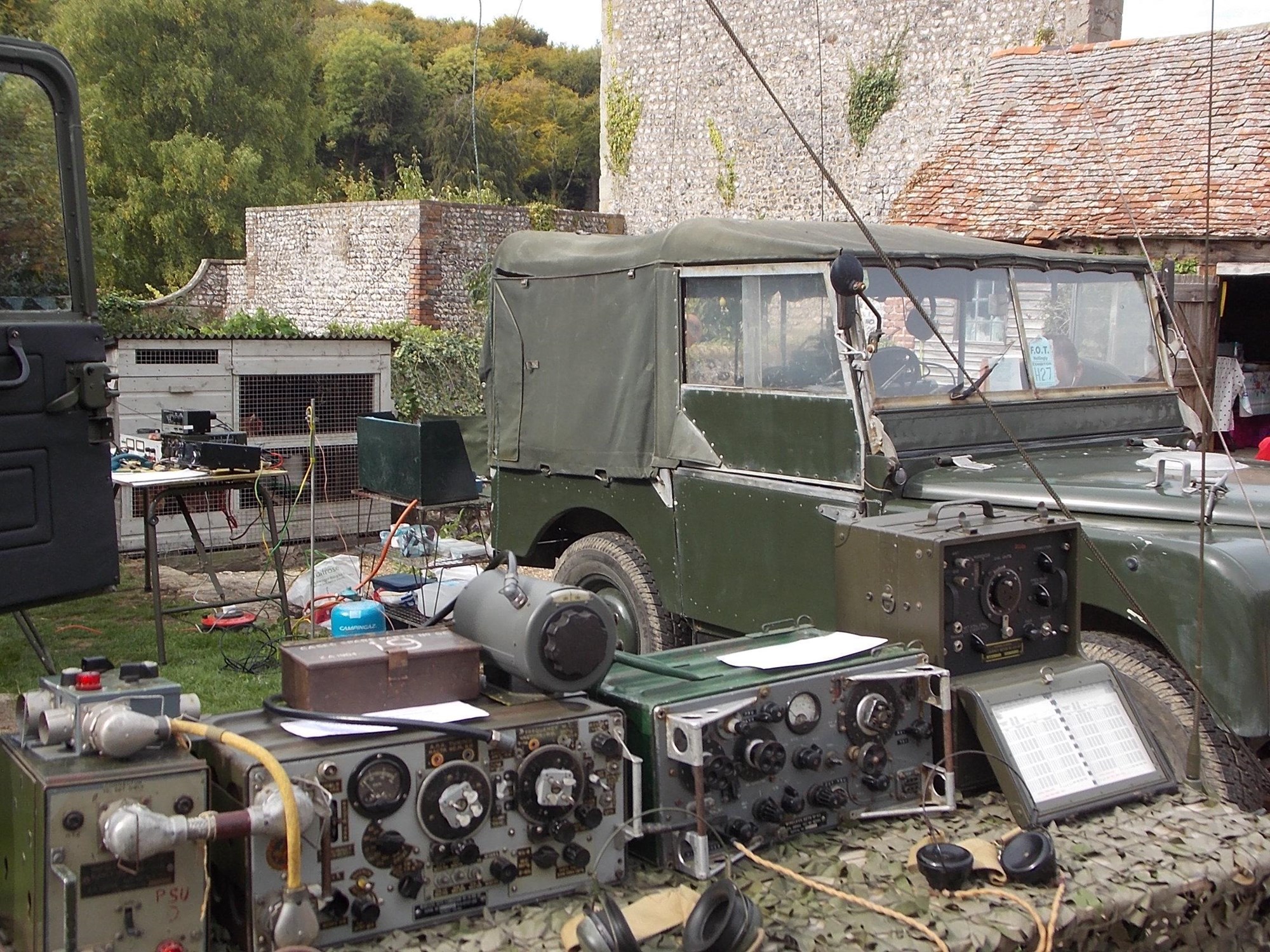
Milton Keynes Amateur Radio Society will be operating a
CW station on their
primary frequency 7.035 Mc/s, 7.020 Mc/s secondary from Windy Ridge at
Whaddon Hall in Buckinhamshire, using Whaddon and Paraset equipment. On 6th June 1944 this site was transmitting ULTRA intelligence decoded at nearby Bletchley Park to the invasion Field Commanders.
ON4ALY, Xavier and friends are travelling from Belgium to a location on or near to the football field at Ranville, location of the river Orne Bridge, operating with the special call
F/ON6JUN/P on HF and 6m in CW, SSB and Digital modes. Xavier says that they would welcome any calls and also visitors to their station. We are hoping that they will be tempted to use AM and FM on our proposed operating frequencies 0f 3615 Kc/s and 51.700Mc/s, perhaps with a piece of ex WWII Belgian Special Forces equipment.
As well as making contacts with Europen stations, it is hoped that communications can be established with some of the historic military vehicles assembled for the 75th event at Arromanche on the western end of British Gold Beach and further west with vehicles at the U.S. Utah and Omaha beaches. To the east of Gold beach are the British Sword and Canadian Juno Beaches where communications are planned to be established on 3.615 Mc/s and 51.700 Mc/s. Any stations permitted to operate on those frequencies are most welcome to join in and it is not necessary to be a VMARS member to do so.. We are encouraging people to put their callsigns, planned location and, if applicable, military vehicle type, onto a list being compiled by Martin Smyth, M0MGA, who can be contacted at
martin-smyth@tiscali.co.uk.
VHF operation
The organisers are aware that a number of vehicles and individuals use Clansman VHF equipment such as the 351, 352 and 353 sets. Martin and Tony will be also be operating a Clansman PRC352, along with David, M0IDFrunning a VRC353 from Pegasus Bridge. VHF operations will take place on 51.700 Mc/s in Frequency Modulation mode at any time during the period that the event takes place..
Advice on operating transmitters in France
British amateurs who hold a full Advanced licence are permitted to operate in France under the international CEPT agreement of which both Britain and France are signatories. UK Intermediate or Foundation licence holders are not permitted to operate in France unless they are supervised by a UK Advanced or a French licence holder, whose callsign only should be used. Radio amateurs from other countries which are signatories to the CEPT agreement and who are permitted to operate in France under CEPT may also supervise operators. It is a requirement that all amateur radio licence holders operating in France must have their licence immediately available for inspection if required. The correct operating protocol is to prefix your UK callsign with the letter F, e.g. F/ M0XYZ.
6 metre allocations in France are the same as they are in the UK, 50.00 Mc/s - 52.00 Mc/s. The VMARS activity co-ordinated for 6th June 2019 will take place on 51.700 Mc/s..Users of modern amateur radio 6m equipment should be aware that military Clansman 351, 352 and 353 VHF sets work using 25Kc/s channel spacing and not 12.5Kc/s as used on amateur sets, so communications channels should be selected accordingly. Clansman VRC353 sets should be selected to transmit and receive NARROW bandwidth. Unless modified, Clansman VHF equipment transmits a sub audio tone of 150 c/s which causes rough sounding transmission to be heard at the receiving end when using modern amateur equipment. Clansman VHF receivers have a filter which overcomes this problem so their receive signals are not affected. However, Clansman VHF set owners operating on amateur bands are strongly advised to modify their sets to turn off the 150 c/s tone and information on making this simple adjustment is widely available on the internet.
Please be aware that there is no amateur radio 4 metre allocation in France and the 70 Mc/s - 70.5 Mc/s available in the UK is widely used by the French military and Gendarmerie. The use of the 4m band for amateur radio in France is unauthorised and illegal.The penalties in France for operating radio equipment on unauthorised frequencies or without a valid licence are severe and can result in confiscation of equipment and of the vehicles from which it is illegally operated.
Event Call sign | Name | Location | Equipment | Vehicle |
Operating Frequencies/Modes
|
F/M0MGA
F/G3YYH | Martin
Tony | 6th June: Chateau de Creully
7th June:
Musee de Radar, Douvres la Deliverande | WS19HP, WS46 Clansman VRC 353 | | 3.615 Mc/s AM
51.700 Mc/s FM |
| F/M0IDF | David | Pegasus Bridge
Bénouville | WS19 MkIII, ZC1
Clansman VHF | 1942 Bedford MWD lorry | 3.615 Mc/s AM
51.700 Mc/s FM
80/40m LSB |
| HMS BelfastFlagship of Bombardment Force E Gold & Juno Beaches | Pool of London | Modern | 24 X 6 inch and 4 inch gun Light Cruiser | 80/40m
LSB |
GB2SF
(Sword Force) | Southdown Amateur Radio Society | Beachy Head | WS19 MkIII
WS62
Clansman VRC322 HF
Clansman VRC353 VHF | Landrover Defender 110 FFR | 3.615 Mc/s AM
51.700 Mc/s FM
HF SSB |
GB1SOE
operated by
MKARS members | Milton Keynes Amateur Radio Society | Whaddon, Buckinghamshire
Location of ULTRA Intelligence distribution to Field Commanders | Whaddon MkIII
Whaddon MkVII Paraset
HRO
Home Built AM | In June 1944 Whaddon Hall was MI6 HQ Section VIII (Communications) commanded by Brigadier Richard Gambier-Parry. The site had direct communications with the Beach Heads during the Invasion | 3.615 Mc/s AM
7.035 Mc/s primary CW
7.020 Mc/s secondary.CW
|
| F/G3ZIB | Dave | St Mere Eglise
Merville Battery
Ranville | Collins TCS
PRC320 | 1943 Willys Jeep
US Navy F.O.O | 3.615 Mc/s AM |
| G0GNE | Robin | Butser Hill
Nr. Portsmouth | Clansman
VRC 353
Clansman
VRC321 | Air Drop Lightweight Landrover | 51.700 Mc/s FM
3.615 Mc/s AM |
G7KNS
M0RYK | Gordon
Mike | Crowborough Camp
East Sussex | WS19 MkIII
Clansman
VRC 353
PRC 320 | Series 1 Landrover | 3.615 Mc/s AM
51.700 Mc/s FM |
| F/M0ZKK | Matt | Grandcamp-Maisy
Nr. Omaha Beach | Clansman
PRC 320
PRC 352 | 1942 Ford Jeep | 3.615 Mc/s AM
51.700 Mc/s FM |
| M0WSN | Ron | Sheldon, Birmingham | Clansman VRC321 | Series LandRover | 3.615 Mc/s AM |
| G4NGV | Tony | Peel Monument, Lancashire (also known as Holcombe Tower) | Clansman
PRC 320
PRC 352 | Series 3 Landrover | 3.615 Mc/s AM
51.700 Mc/s FM |
HB9FWY
HB9EPC
TM75UTAH | Pierre
Christian | Utah Beach
(with MVCG-SR club from Switzerland) | SCR399 | Jimmy deuce-and-a-half
(GMC 353) | 3.600 Mc/s AM |
Organisations and individuals who are planning to operate stations from locations in England or France where D-Day activity took place are invited to add their details to the above list and join in with the vintage wireless communications on 6th June. Please contact Martin Smyth atmartin-smyth@tiscali.co.uk with details
Note for those indending to travel in the Normandy Beaches area on 6th June 2019
As this is the 75th anniversary of D-Day there are few left alive who actually took part in or witnessed these momentous events and are able to attend a significant.anniversary in person for probably the last time. Due to the significance of the occasion the area will be visited by numerous senior political, royal and military representatives from countries directly involved in the landings and in the Battle of Normandy, so requiring extensive security arrangements to be put in place. These are likely to impede travel along the coastal areas at times, so participants planning to travel to Normandy for this occasion are advised to make alternative secondary arrangements as a back up for their primary plan should it prove necessary in the event of access being restricted. At Ver-Sur-Mer, opposite Gold Beach the French President, Mr Macron and the UK Prime Minister, Mrs May are scheduled to lay a foundation stone for a memorial being built to remember the 22,000 troops under British command who died in the Normandy actions. Other points of significance are likely to be affected as VIP's visit them. See https://www.gov.uk/government/news/french-authorities-announce-travel-arrangements-for-d-day-75-in-normandy for more details.
.

Tides - The beach at Arromanches is accessible for vehicles for a couple of hours each side of low water. Please note that access to the beaches with vehicles is controlled by the local harbour authorities.
Local times of the tides on 6th June are:-| Arromanches High Water | 00:19 | 7.25m | |
Arromanches Low Water | 07:56 | 1.05m | |
Arromanches High Water | 12:53 | 7.00m | |
Arromanches Low Water | 20:14 | | |
For Arromanches tides on other dates click here For tides at other Normandy beaches click here
C47 Dakota's flying over Normandy for the 75th D-Day anniversary
As part of the 75th anniversary, what is claimed to be one of the largest concentrations of C47 Dakota aircraft in recent times will be flying over Normandy out of
Caen Carpiquet airfield. Mass parachute drops are planned and further information on this event can be found on
this link. The Caen
Carpiquet Tower frequency is
134.525 Mc/s.
The Carpiquet airfield was captured by the Luftwaffe in June 1940 and was used by them as a base for operations in the Battle of Britain. In July 1944 and following several weeks of fierce fighting by British and Canadian artillery and ground troops, the German held airfield was taken and used as a forward base for Allied airforces.
 Click on the family picture to listen to 1940s radio music
Click on the family picture to listen to 1940s radio music Click on the BBC microphone to hear D-Day News reports 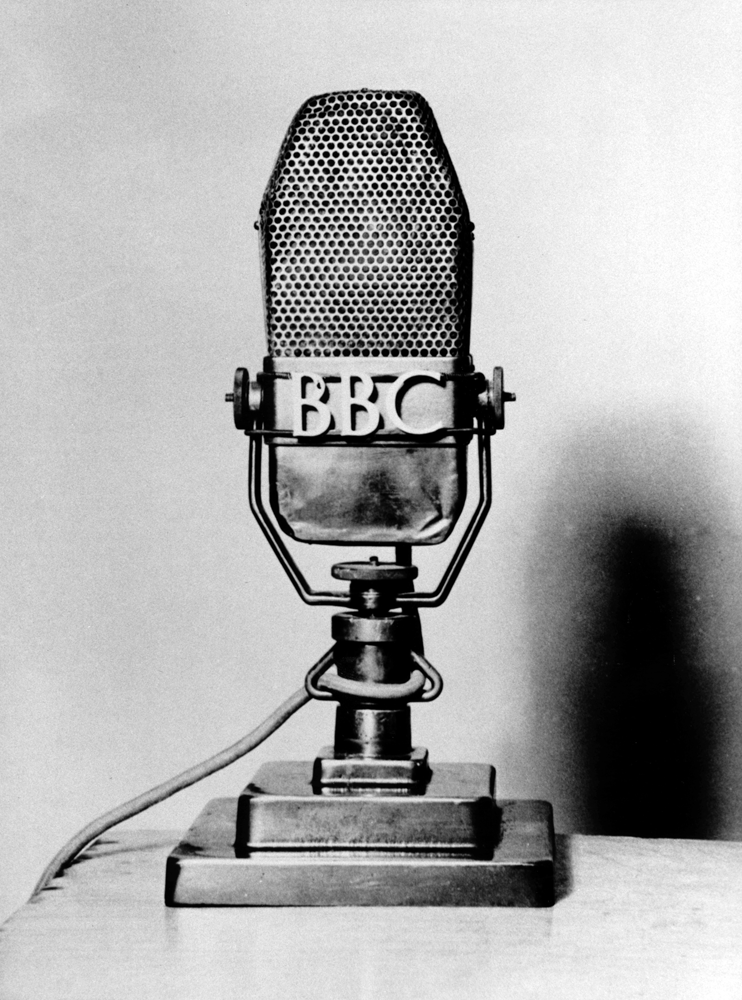
Flying restrictions
There will be formal exclusions zones for flying in 6th June 2019, both for security purposes and to allow clear access for special flights. The map below is taken from the NOTAM and shows the general area of restriction and the two specific areas of exclusion.
Photographs of the activities undertaken by VMARS members on the South Coast of England and the Normandy coast of France during the period of the 75th anniversary of D-Day.
Some photgraphs have links to audio recordings, information sites and YouTube
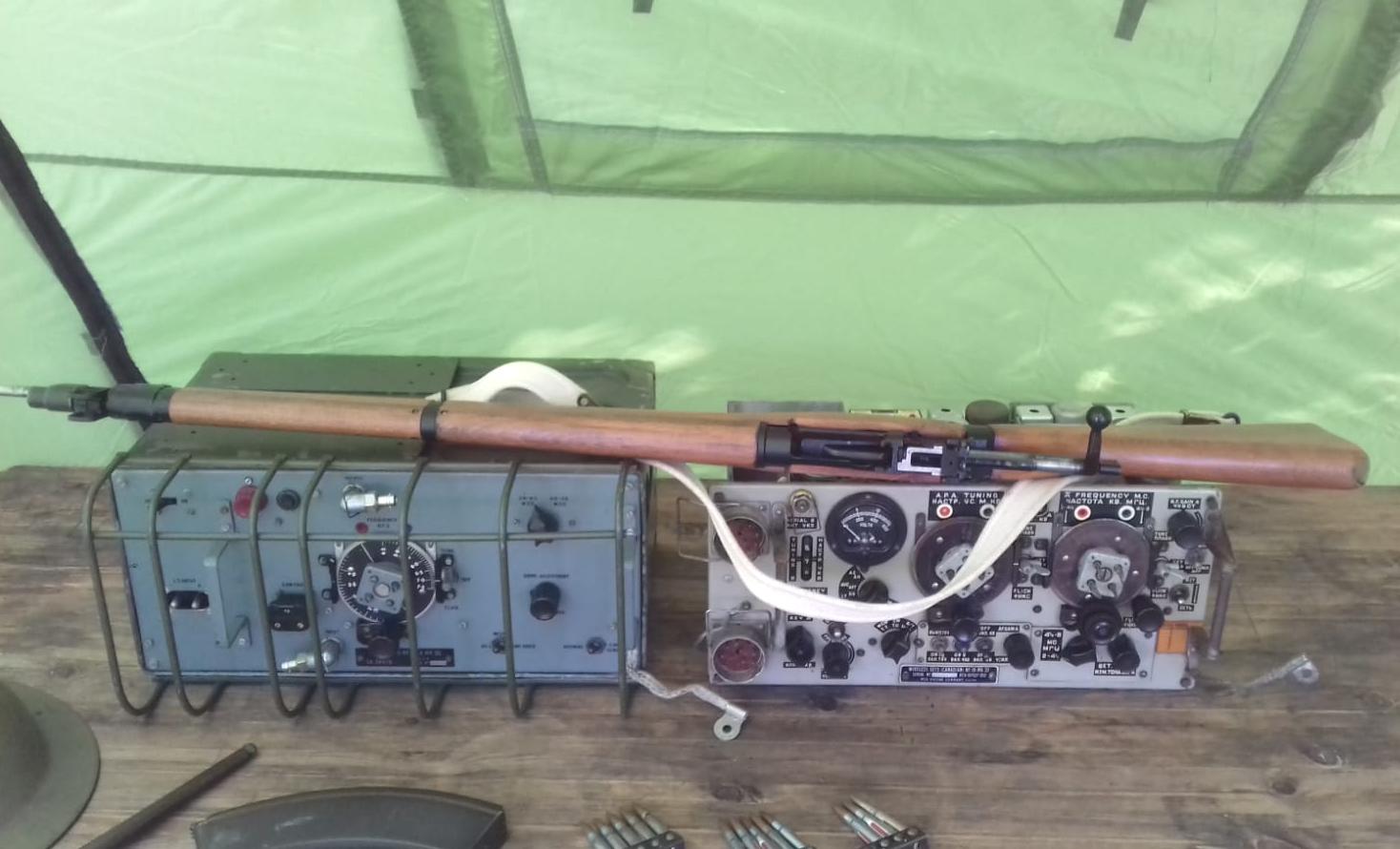
Preparing for the 75th D-Day adventure. The .303 rifle and ancilliaries were the only passport and permit that was required for getting into France for the British troops landing in Normandy on 6th June 1944. This time a special permit was required for travel within a 5Km security exclusion zone set up by the French authorities to protect the many VIP's in attendance along the Normandy Beaches.
The planned access by VMARS members to Gold King Red Beach was thwarted by a memorial foundation stone laying ceremony at Ver-Sur-Mer, Gold Beach, where Prime Minister Mrs May and President Macron were the official guests of honour. The overdue memorial is being erected in remembrance of the 22,000 troops under British command who gave their lives in the Battle for Normandy. 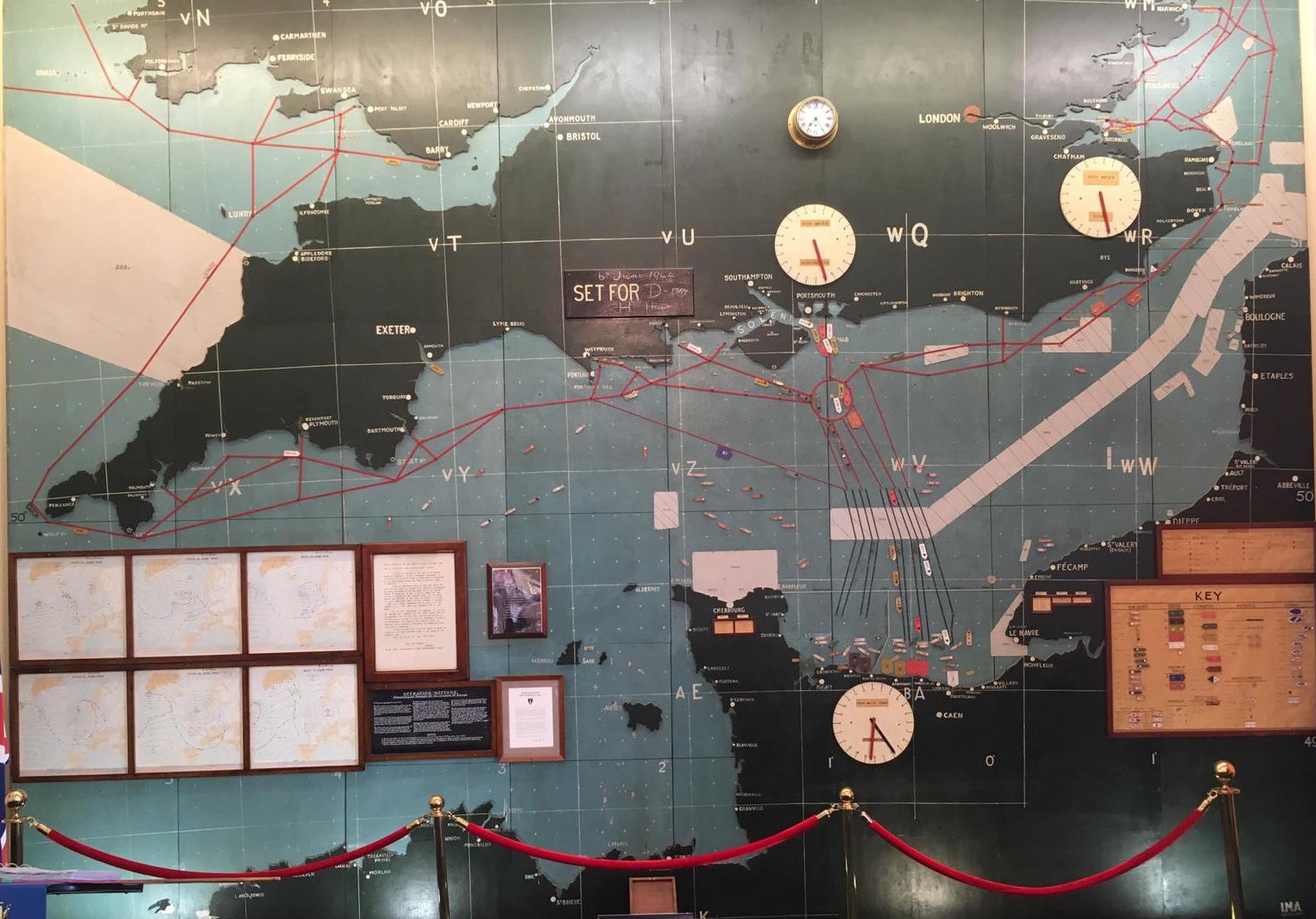
Above - The Situation Map & Key for Operation Neptune, located in the Map Room of General Eisenhower's D-Day Headquarters at Southwick House, Portsmouth. It is set as the situation was at H-Hour (the opening of the attack) on D-Day, 6th June 1944
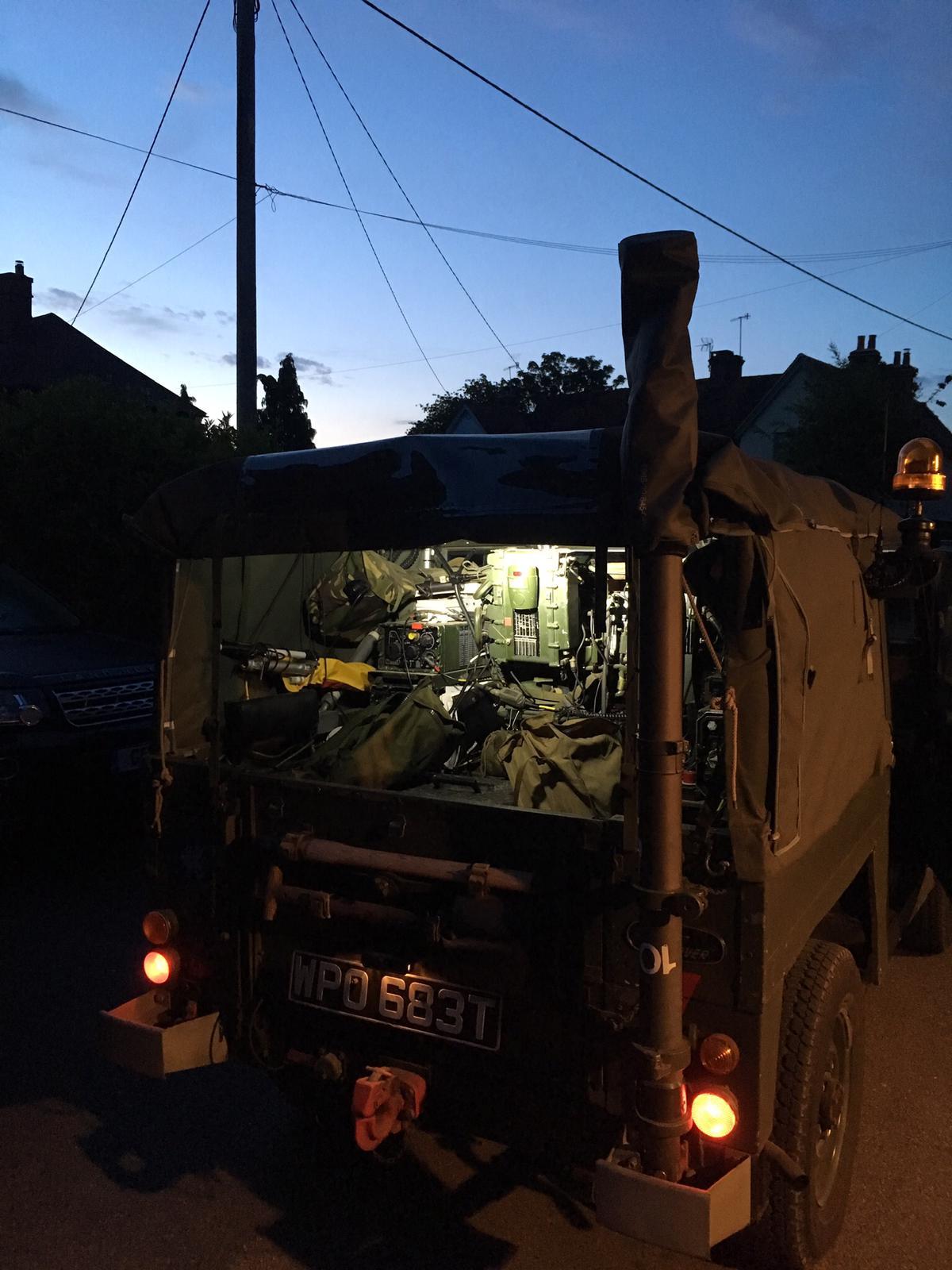
An early start for Robin, G0GNE
G0GNE, Robin Maddison's Lightweight Air Portable Landrover about to be set up for operation from Butser Hill, looking towards Portsmouth Harbour. It had been hoped that as well as working on 3615 Kc/s across to Normandy, which wasn't a problem, a link could also be established on the 6 metre FM frequency of 51.700 Mc/s. The hoped for summer lift conditions did not appear and none of the 6m stations located on the South Coast managed to contact stations in France. However, 51.700 Mc/s contacts were established between several of the South Coast stations and also between several stations operating in France.
Jonathan Wymer, G8URE, put up this 6m beam for comms on 51.700 Mc/s at his home near Chichester but didn't manage to make contact with Normandy
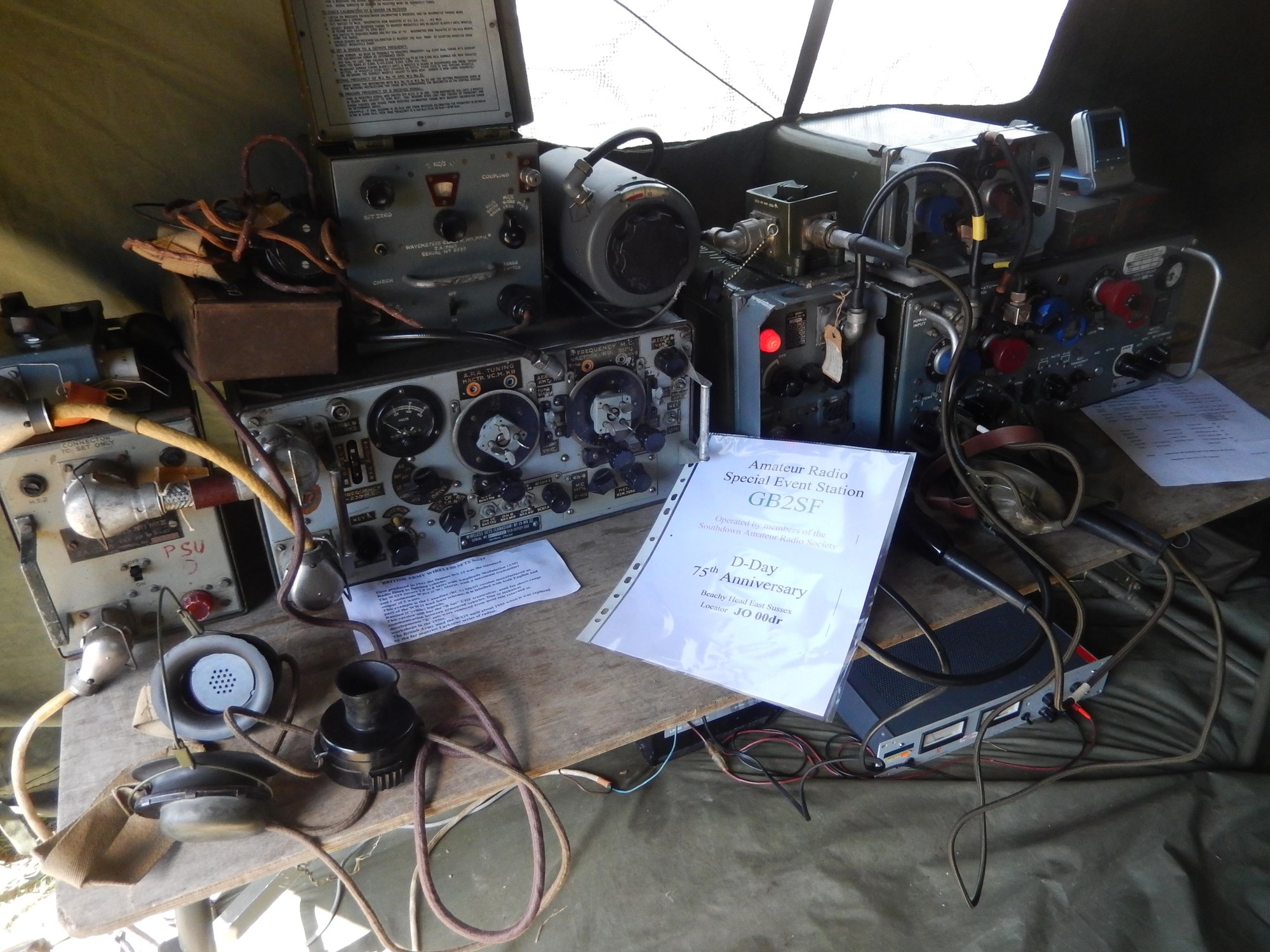 The 75th D-Day Anniversary station of GB2SF (Sword Force) located at Beachy Head and operated by the Southdown Amateur Radio Society
The 75th D-Day Anniversary station of GB2SF (Sword Force) located at Beachy Head and operated by the Southdown Amateur Radio Society 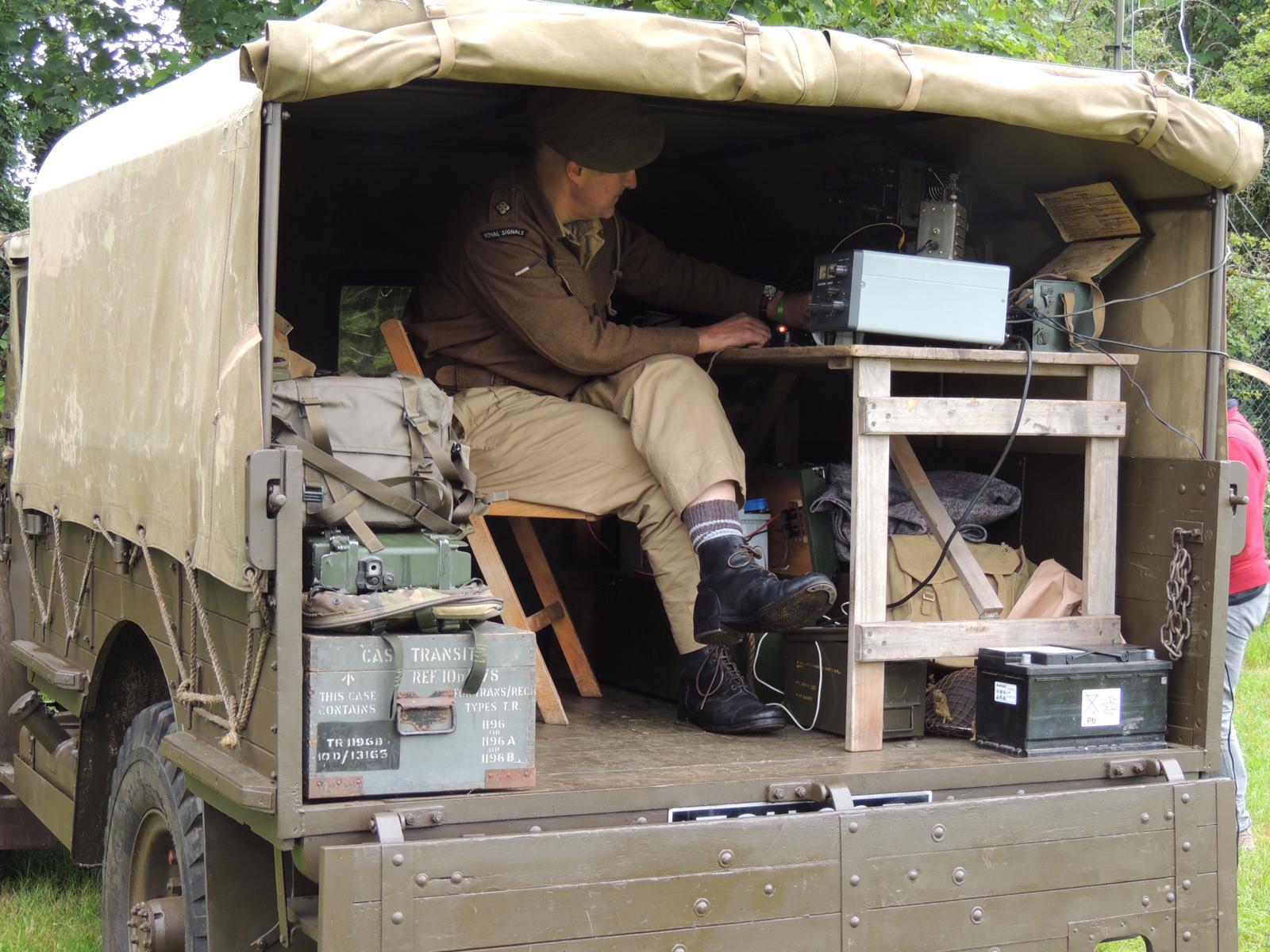
Above - David Coles, F/M0IDF, at Pegasus Bridge with his ZC1 transceiver equipped 1942 Bedford MWD lorry
Below - on the beach at Arromanches with Mulberry Harbour remains visible in the background
Clive - F/M0IEW at Pegasus Bridge using a Clansman 351 on 51.700 Mc/s
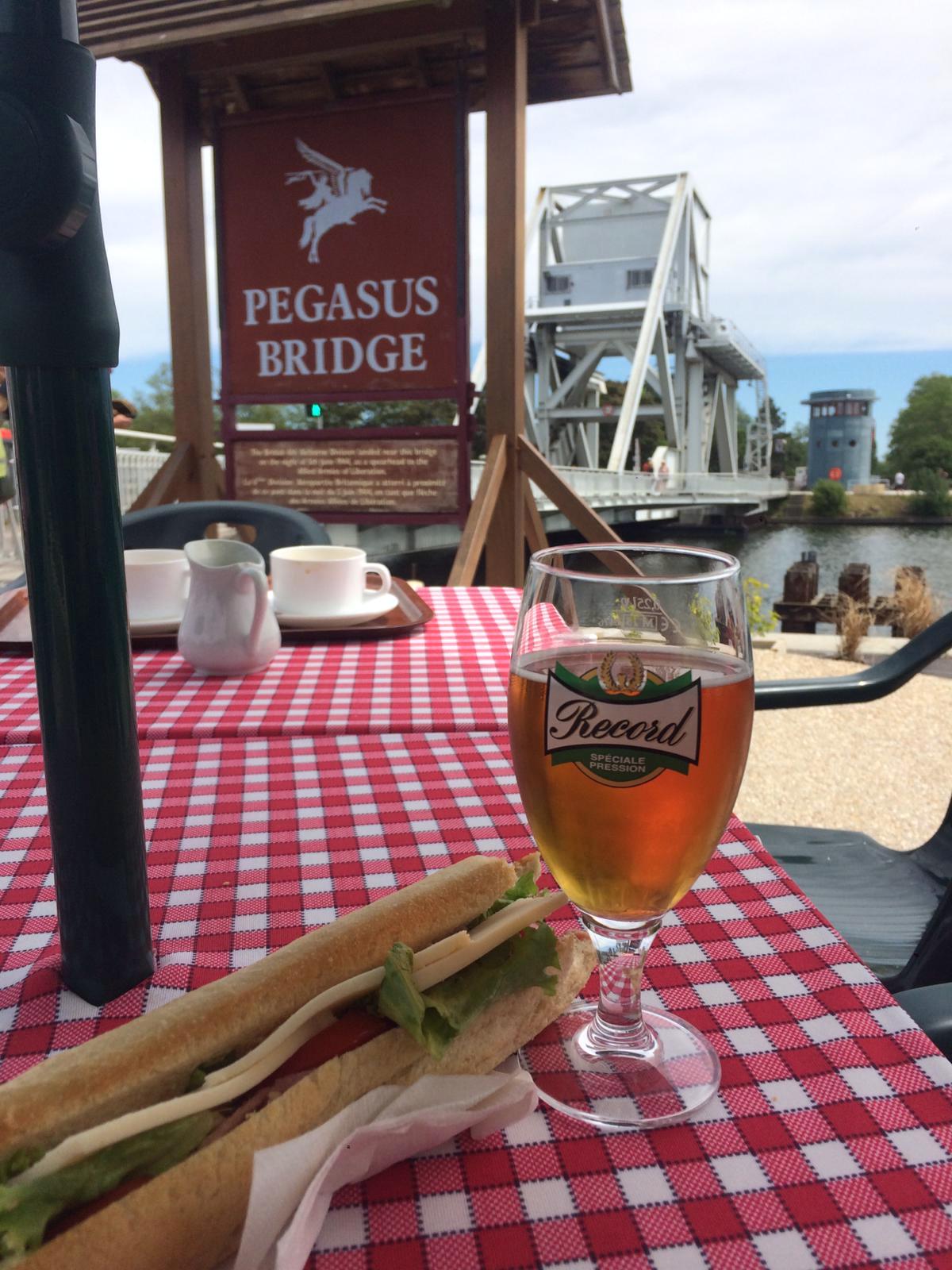 A typical location where VMARS members can frequently be found - in the bar that is.
A typical location where VMARS members can frequently be found - in the bar that is. 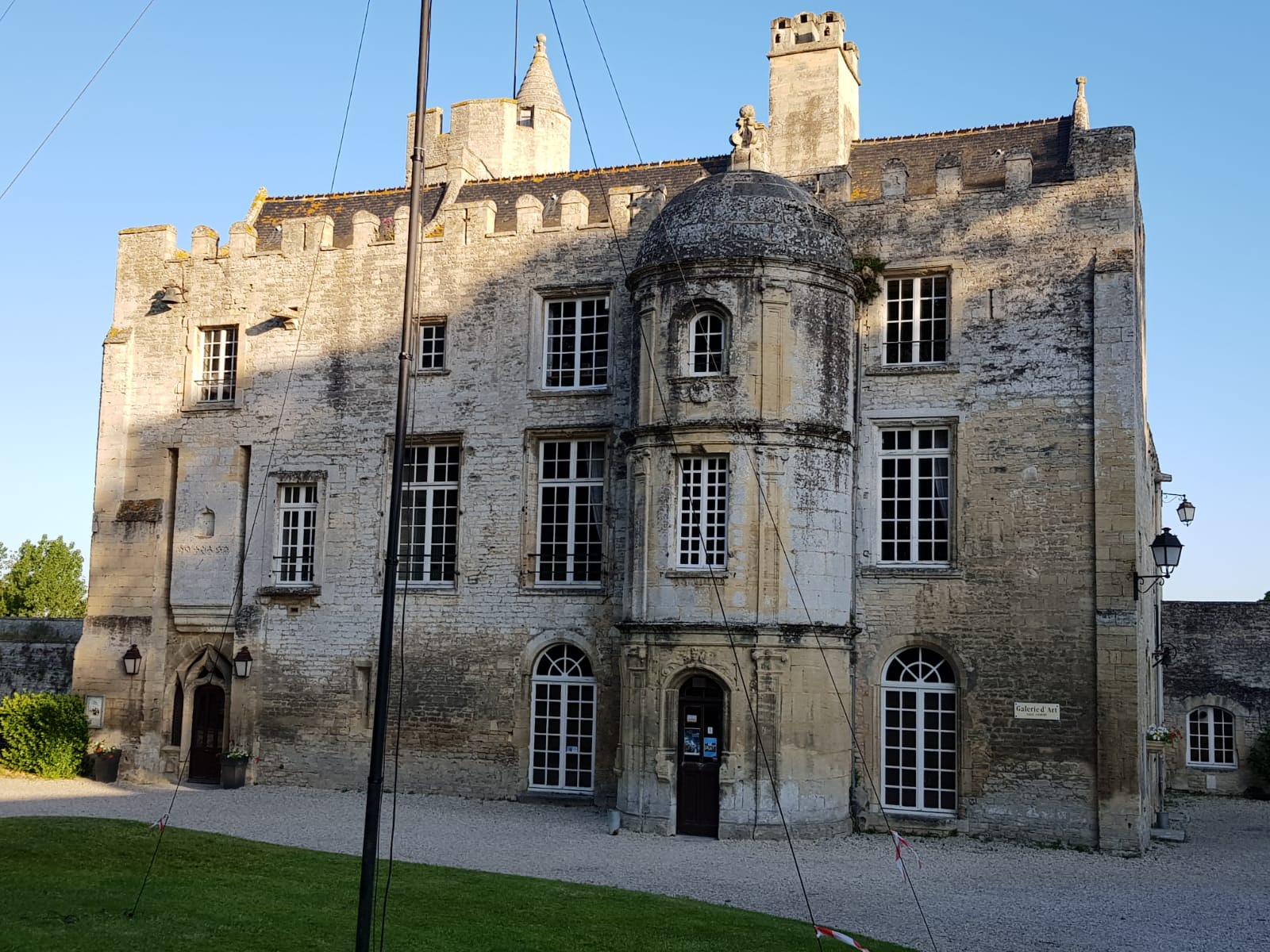 The Chateau de Creully with the F/G3YYH and F/M0MGA aerial strategically placed on the front lawn. This is where the BBC set up their first reporting studio immediately following D-Day and there is a small museum representing that event on the upper floor where the studio was located. For several weeks it was the busiest wireless studio in the world, sending out reports received from dozens of news correspondents positioned in the battle zone. Local authorities kindly made this operating location available to the VMARS D-Day group as a base for transmissions made on the 6th June anniversary.
The Chateau de Creully with the F/G3YYH and F/M0MGA aerial strategically placed on the front lawn. This is where the BBC set up their first reporting studio immediately following D-Day and there is a small museum representing that event on the upper floor where the studio was located. For several weeks it was the busiest wireless studio in the world, sending out reports received from dozens of news correspondents positioned in the battle zone. Local authorities kindly made this operating location available to the VMARS D-Day group as a base for transmissions made on the 6th June anniversary. 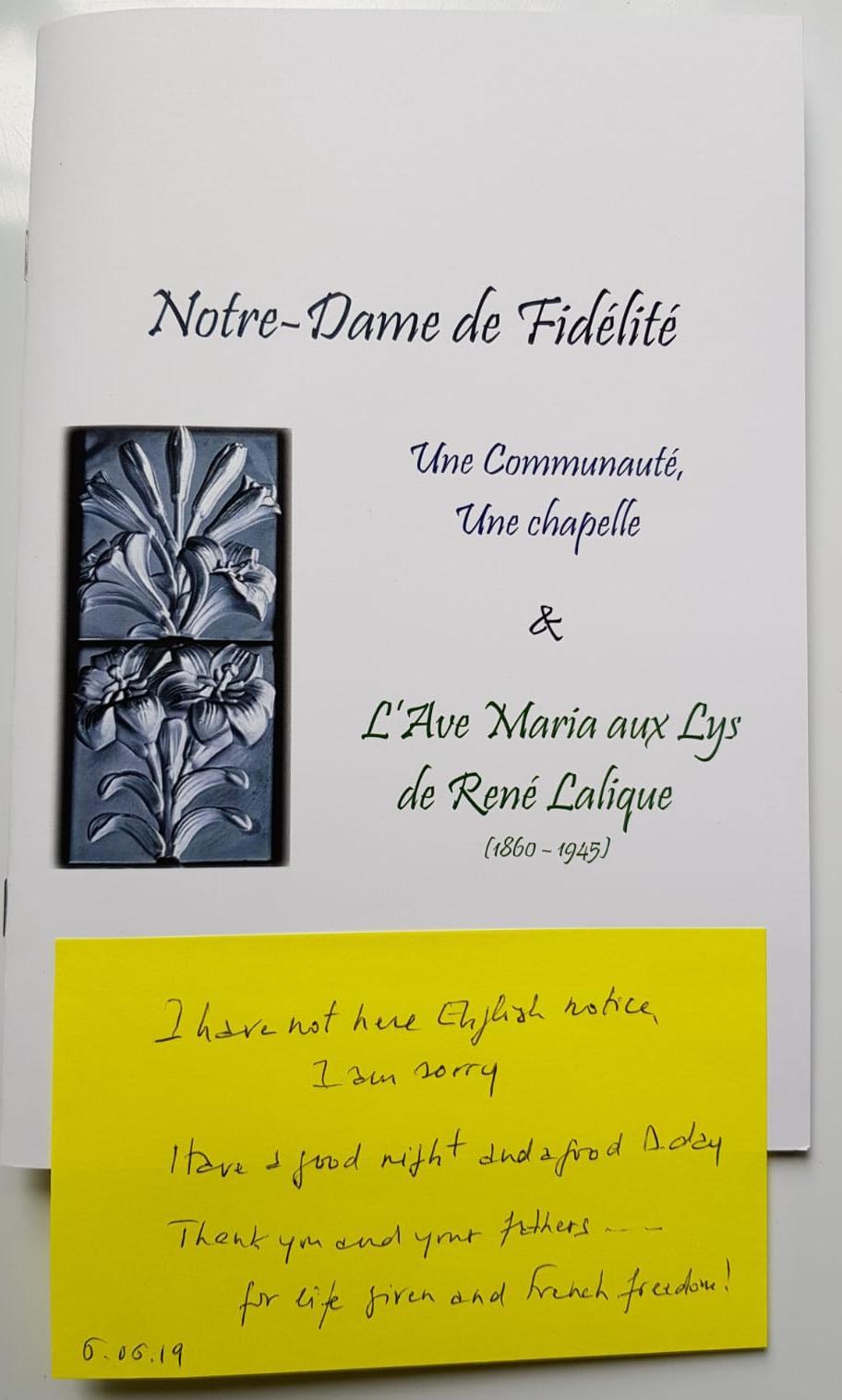
Such was the warm and generous welcome from their French hosts at Douvres, Tony and Martin were provided with overnight accommodation in the local Convent Notre-Dame de Fidelite in the town, which is 7 miles (11Km) East of Creully and just 2 miles, (3.3Km) from the beaches. The 97 year old Mother Superior has said in a recorded interview that as a young nun she had watched from the 4th floor balcony as the D-Day invasion fleet arrived. She left this poignant note on Tony's door, one of several similar expressions of gratitude from local French people for the sacrifices made.
Note: Douvre is now known as Douvres-la-Délivrande.The name was changed in 1961 and was expanded to refer to the basilica Notre-Dame de la Délivrande (Our Lady of Deliverance), which is a site of pilgrimage in the town.
For more information about Douvres-la-Délivrande Click here 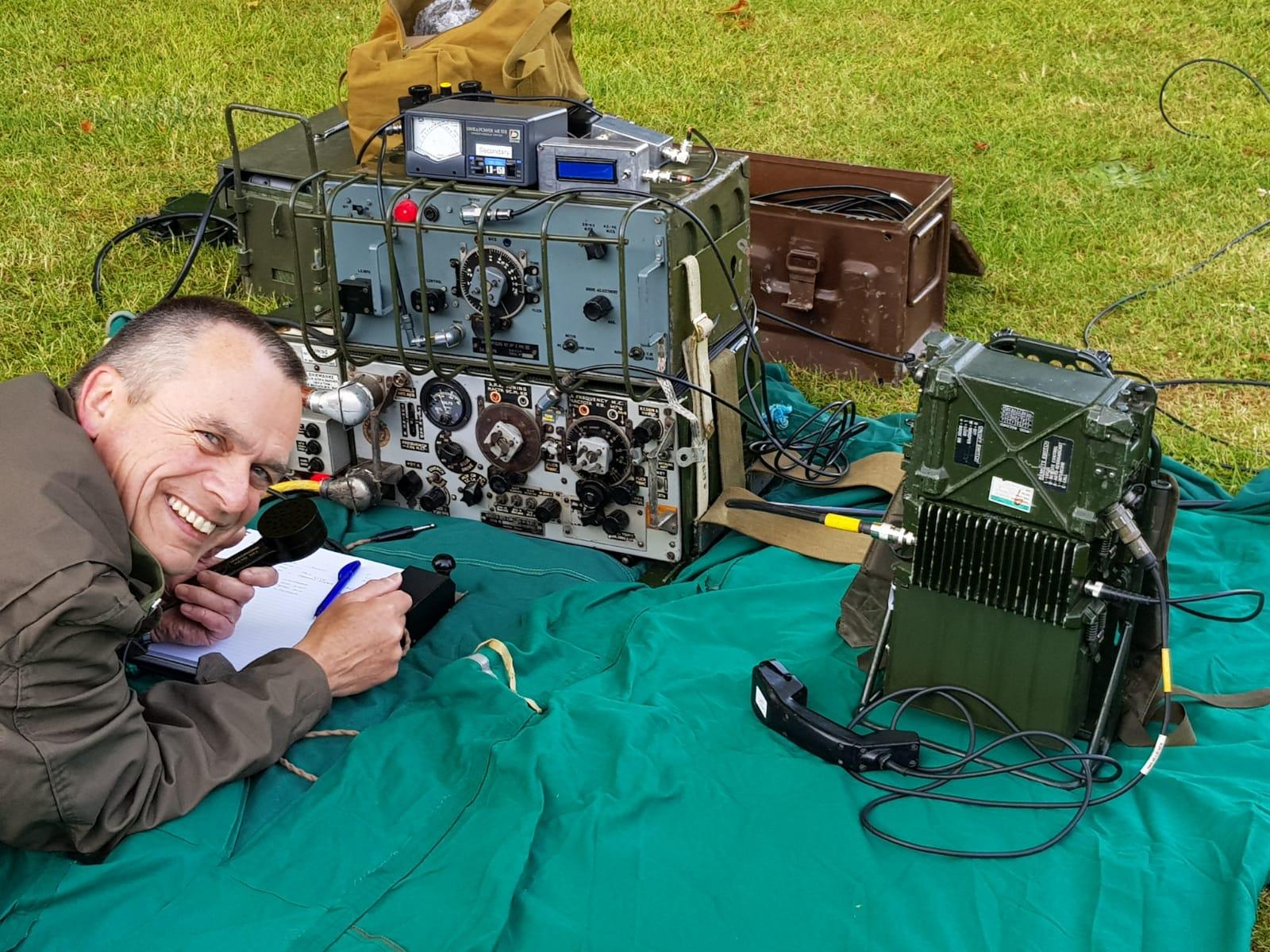
This Canadian Wireless Set No.19 and its associated High Power RF amplifier was the station used by Martin and Tony on 6th June at the Chateau de Creully. The radio to the right of the WS19 is a Clansman PRC352 VHF manpack for use on 51.700 Mc/s
Martin, F/M0MGA, demonstrates the prone position for operating under fire. The more likely explanation is that he had an uncomfortable night under canvas and was catching up on his rest.
Click on the above picture to listen to the first hour of the D-Day 75th Anniversary net on 3615 Kc/s
This was recorded in Brittany, North West France, between 06:30 and 07:30 BST.
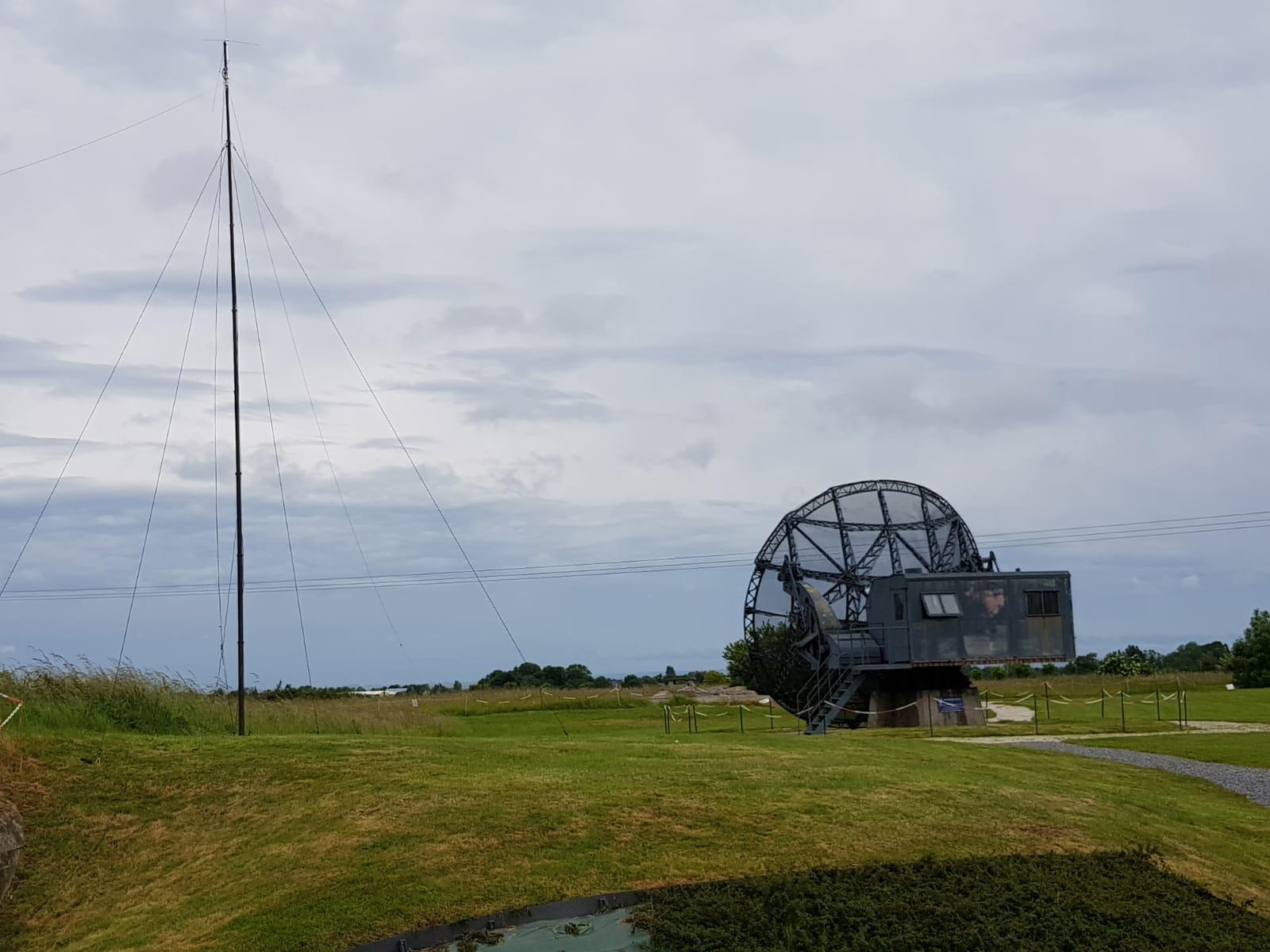 On 7th June F/G3YYH and F/M0MGA relocated their station a few kilometres to the former German radar station at Douvres, now a very interesting museum which includes their very effective Wurzburg and Freyer radars, sadly not in working condition. Tony and Martin's aerial can be seen planted on top the impressive bunker (see below) and a short distance from the Wurzburg radar scanner. As a former member of the Royal Signals, Martin took the opportunity to fly the regimental flag from their mast. Once again the use of this facility was arranged by the very helpful French local authorites of the Douvres village. As well as making operating sites available for the VMARS duo, they arranged the necessary special permits for Tony, Martin and their vehicle, allowing movement within the restricted security area. They also invited them to attend a remembrance service at a local war cemetary and a civic champagne reception arranged for dignitaries from twin towns in both Germany and England.
On 7th June F/G3YYH and F/M0MGA relocated their station a few kilometres to the former German radar station at Douvres, now a very interesting museum which includes their very effective Wurzburg and Freyer radars, sadly not in working condition. Tony and Martin's aerial can be seen planted on top the impressive bunker (see below) and a short distance from the Wurzburg radar scanner. As a former member of the Royal Signals, Martin took the opportunity to fly the regimental flag from their mast. Once again the use of this facility was arranged by the very helpful French local authorites of the Douvres village. As well as making operating sites available for the VMARS duo, they arranged the necessary special permits for Tony, Martin and their vehicle, allowing movement within the restricted security area. They also invited them to attend a remembrance service at a local war cemetary and a civic champagne reception arranged for dignitaries from twin towns in both Germany and England. 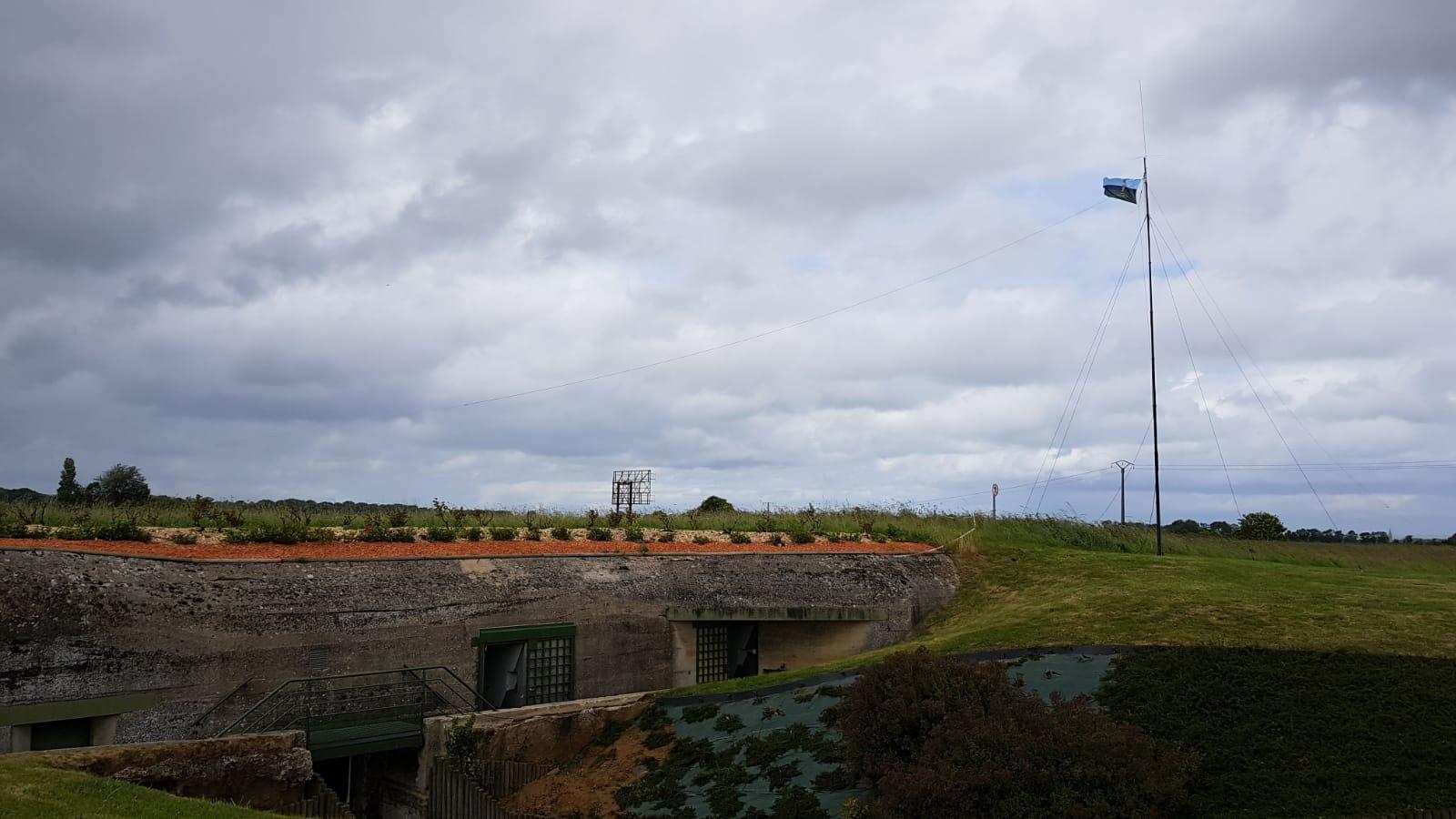 Although only a short distance inland, the Douvres radar station wasn't captured until 17th June, 11 days after D-Day, following an intense battle. Click on the picture above to see details of the Battle of Douvre Radar Station.
Although only a short distance inland, the Douvres radar station wasn't captured until 17th June, 11 days after D-Day, following an intense battle. Click on the picture above to see details of the Battle of Douvre Radar Station. Martin, F/M0MGA waving the Blue Ensign to honour the many Royal Navy reservists who served in ships that took part in Operation Neptune to bring the Invasion Force to Normandy. The right to fly a Blue Ensign was granted by a warrant issued by the Admiralty and was frequently flown by civilian ships that had been commandeered for Admiralty operations and crewed by Royal Navy reservist officers.
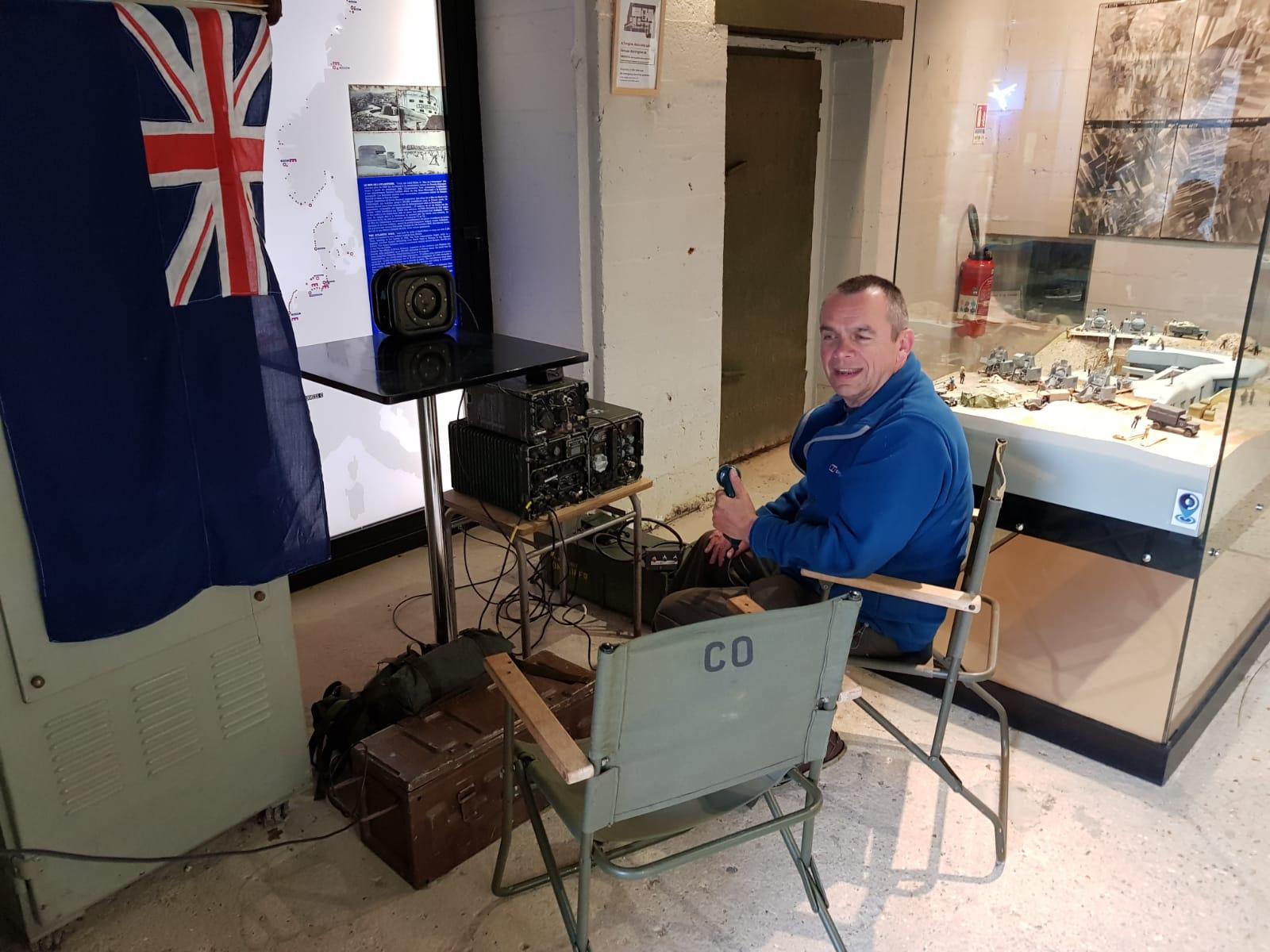 Martin, F/M0MGA, sheltering from the rain and operating on 7th June from inside the Douvres Radar Museum bunker with a Clansman VRC321
Martin, F/M0MGA, sheltering from the rain and operating on 7th June from inside the Douvres Radar Museum bunker with a Clansman VRC321VMARS Chairman Tony Barron, F/G3YYH (nearest to camera) and Martin Smyth, F/M0MGA, operating as the Net Control station for the VMARS Saturday morning AM net on 8th June from a WW2 radio truck on UTAH Beach using a BC610. The fully functioning ex-Swiss Army SCR-399 GMC lorry mounted cabin is owned by Pierre Dubuis, HB9FWY and was fully restored by him with some help from his dad Christian, HB9EPC. The cabin is fitted with a BC312 , BC342 , BC610 E, BC939 and a BC614 and Pierre very generously made the station available to Tony and Martin to run the Saturday morning AM net. This proved to be a great success with strong signals from Normandy heard by stations on the net as far away as the North of England, the Netherlands and North West France as well as by monitoring stations in Switzerland.
Click on the picture above to be taken to a 20 minute recording of the station operating from UTAH beach. Conditions were not great so the recording has been edited to remove stations not heard at the recording location in Brittany, about 112 miles (180 Km) South West of UTAH Beach.
New friends Pierre Dubuis, HB9FWY and Martin Smyth, F/M0MGA in front of Pierre's SCR-399 mounted radio truck, which is the famous U.S WWII two and half ton GMC Jimmy Deuce and a Half. Jimmy is slang for GMC.
During the Anniversary period Pierre was using the special callsign TM75UTAH.
VMARS Chairman Tony Barron, F/G3YYH takes a break from the Saturday net
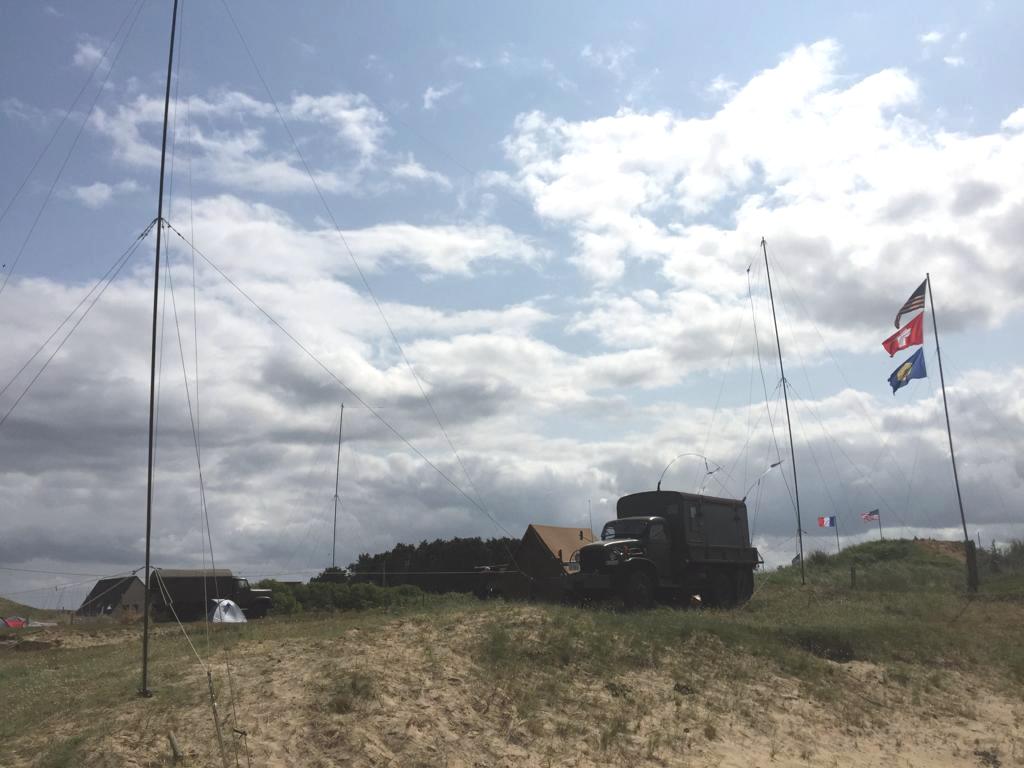 View of the radio vehicles at UTAH Beach
View of the radio vehicles at UTAH BeachChristian Dubuis, HB9EPC, alongside the wonderful SCR-399 wireless station at UTAH Beach
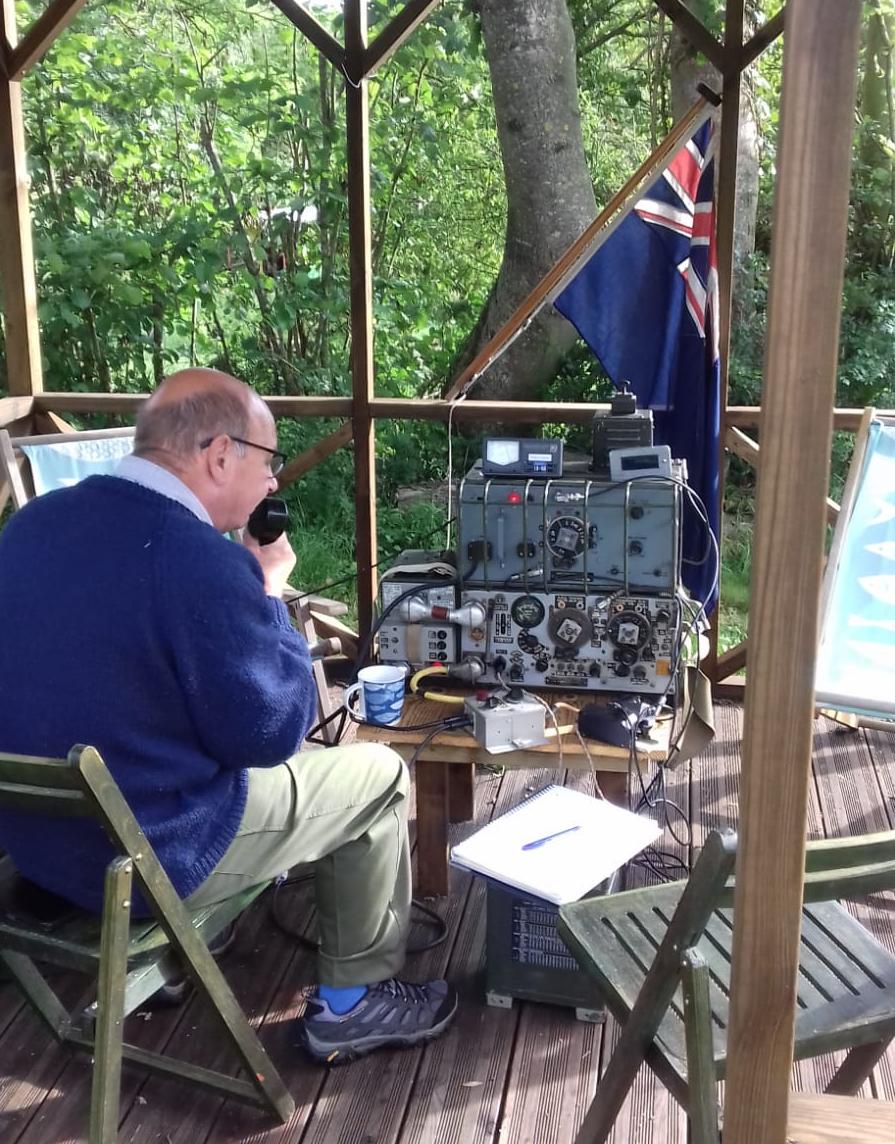 9th June - After catching up on a good nights sleep at a Barron family house near Alencon, 100Km south of the Normandy beaches, Tony, F/G3YYH joined a net on 3615 Kc/s using the WS19 and HP amplifier.
9th June - After catching up on a good nights sleep at a Barron family house near Alencon, 100Km south of the Normandy beaches, Tony, F/G3YYH joined a net on 3615 Kc/s using the WS19 and HP amplifier.